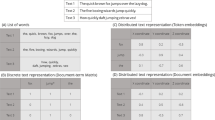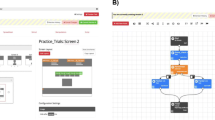Abstract
We describe a large-scale, low-cost, project that has examined the way people develop their skill in using fundamental software tools. The study involved over 2000 users during a three-year period of use of the sam text editor. The work took place while the editor was being employed in normal day to day work — it was not a laboratory experiment. Our main contributions are first to demonstrate very long-term, low-cost monitoring with collections of simple analysis tools. Second, we have started to develop an understanding of how usability changes in the long term. Third, studies of usability often concentrate on assessment before a system is released for widespread use, whereas ours can help inform the long-term design of new tools — a different dimension of usability. In addition we have mixed snap-shot studies with descriptions of long-term, gradual change. We can track the full development of the user, even though the quality of the data is lower than that normally associated with usability studies.
Similar content being viewed by others
References
Allwood, C.M. and Eliasson, M. (1987) Analogy and other sources of difficulty in novices very first text-editing. International Journal of Man-Machine Studies 27, 1–22.
Booth, P. (1989). An Introduction to Human-Computer Interaction (Lawrence Erlbaum Associates, Hillsdale, NJ.
Bosser, T. (1987) Learning in Man-Computer Interaction. ESPRIT Research Report, Project 385, Springer-Verlag.
Card, S.K., Moran, J.P. and Newell, A. (1983) The Psychology of Human-Computer Interaction (Lawrence Erlbaum, Hillsdale, NJ).
Chapanis, A. (1991) Evaluating usability, in Human Factors for Informatics Usability, Shackel, B. and Richardson, S. (eds). (Cambridge University Press, Cambridge) pp. 359–395.
Cook, R. (1991) Viewable individual user models for a text editor, unpublished. Honours thesis, Basser Dept of Computer Science, University of Sydney.
Cook, R. and Kay, J. (1993) Tools for Viewing um User Models. SSRG Report 93/3/50.1, SSRG, Dept of Computer Science, University of Sydney, Australia.
Cook, R. and Kay, J. (1994) The justified user model: a viewable, explained user model, in UM94: User Modeling Conference, Hyannis, Cape Cod, USA, pp. 184–190.
Draper, S.W. and Barton, B. (1993) Learning by exploration, and affordance bugs, in Adjunct Proceedings of INTERCHI'93, Ashlund, S., Mullet, K., Henderson, A., Hollnagel, E. and White, T. (eds) (ACM, Amsterdam, Netherlands) pp. 75–76.
Eason, K.D. (1984). Towards the experimental study of usability. Behaviour and Information Technology 3, 133–143.
Egan, D.E. (1988) Individual differences in human-computer interaction, in Handbook of Human-Computer Interaction, Hedlander, M. (ed.) (North-Holland, Amsterdam) pp. 543–568.
Greenberg, S. and Whitten, I.H. (1988) Directing the user-interface: How people use command-based computer systems, in Analysis, Design and Evaluation of Man-machine systems — Proceedings of the Third IFAC/IFIP/IEA/IFORS Conference, Oulu, Finland, Ranta, J. (ed.) (Pergamon Press, Oxford) pp. 349–355.
Hanson, S.J., Kraut, R.E. and Farber, J.M. (1984) Interface design and multivariate analysis of UNIX command use. ACM Transactions on Office Information Systems 2(1), 42–57.
Jordan, P.W., Draper, S.W., MacFarlane, K.K. and McNulty, S. (1991) Guessability, learnability, and experienced user performance, in HCI '91 People and Computers VI: Usability Now! Diaper, D. and Hammond, N. (eds) (Cambridge University Press, Cambridge) pp. 237–245.
Kay, Dana S. and Black, John B. (1990) Knowledge transformations during the acquisition of computer expertise, in Cognition, Computing and Cooperation, Robertson, S.P., Zachary, W. and Black, J.B. (eds) (Ablex, Norwood, NJ) pp. 268–303.
Kay, J. (1990) um: a user modelling toolkit, in Second International User Modelling Workshop, p. 11.
Kay, J. (1994) The um Toolkit for Reusable, Long Term User Models. SSRG Report 94/3/36.2, March.
Lindgaard, G. (1993) Usability Testing (Chapman and Hall, London).
Mack, R.L., Lewis, C.H. and Carroll, J.M. (1983) Learning to use office systems: problems and prospects, ACM Trans on Office Information Systems 1, 254–271.
Mul, S.de, vanOostendorp, H. and White, T. (1994) Learning user interfaces by exploration, in Human-Computer Interaction: From Individuals to Groups in Work, Leisure, and Everyday Life. Proceedings of 7th European Conference on Cognitive Ergonomics, Oppermann, R., Bagnara, S. and Benyon, D.R. (eds) (Gesellschaft fur Mathematik und Datenverarbeitung, Sankt-Augustin: GMD) pp. 135–142.
Pike, R. (1987) The text editor sam. Software Practice and Experience 17, 813–845.
Pike, R., Presotto, D., Thompson, K. and Trickey, H. (1990), Plan 9 from Bell Labs, in Proceedings of the Summer 1990 UKUUG Conference, London, July 1990, pp. 1–9.
Poller, M.F. and Garter, S.K. (1983) A comparative study of moded and modeless text editings by experienced editor users, in Human Factors in Computing Systems. CHI '83 Conference Proceedings, (ACM), New York) pp. 166–170.
Rieman, J. (1994) Learning strategies and exploratory behaviour of interactive computer users, unpublished PhD dissertation, University of Colorado, Department of Computer Science.
Roberts, T.L. and Moran, T.P. (1983) The evaluation of text editors: methodology and empirical results, CACM 26(4), 265–283.
Rosson, M.B. (1984) Patterns of experience in text editing, in Human Factors in Computing Systems, Proceedings of CHI '83 Conference, Janda, A. (ed.) (North-Holland, Amsterdam) pp. 171–175.
Sebrechts, M.M., Marsh, P.L. and Furstenburg, C.T. (1990) Integrative modelling: changes in mental models during learning, in Cognition, Computing and Cooperation, Robertson, S.P., Zachary, W. and Black, J.B. (eds) (Ablex, Norwood, NJ) pp. 338–398.
Shackel, B. (1991) Usability — context, framework, definition, design and evaluation, in Human Factors for Informatics Usability, Shackel, B. and Richardson, S. (eds) (Cambridge University Press, Cambridge) pp. 21–38.
Young, R.M. and MacLean, A. (1988) Choosing between methods: analysing the user's decision space in terms of schemas and linear models, in Human Factors in Computing Systems, Proceedings of CHI '88, Soloway, E., Frye, D. and Sheppard, S.B. (eds) (ACM) pp. 139–144.
Author information
Authors and Affiliations
Rights and permissions
About this article
Cite this article
Cook, R., Kay, J., Ryan, G. et al. A toolkit for appraising the long-term usability of a text editor. Software Qual J 4, 131–154 (1995). https://doi.org/10.1007/BF00402716
Issue Date:
DOI: https://doi.org/10.1007/BF00402716




